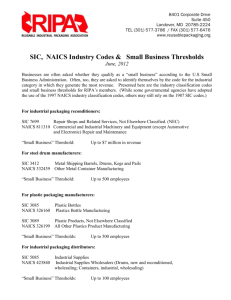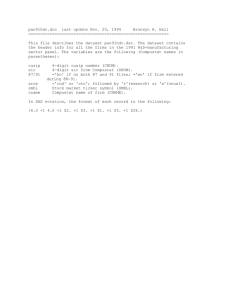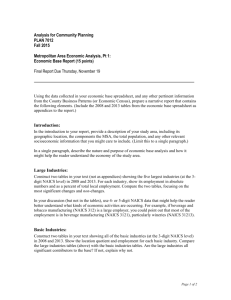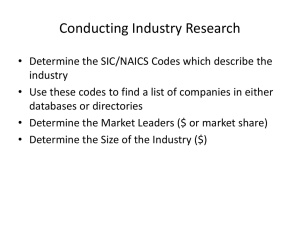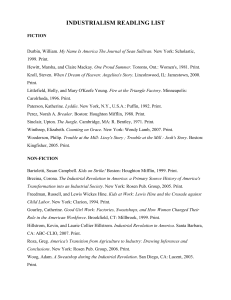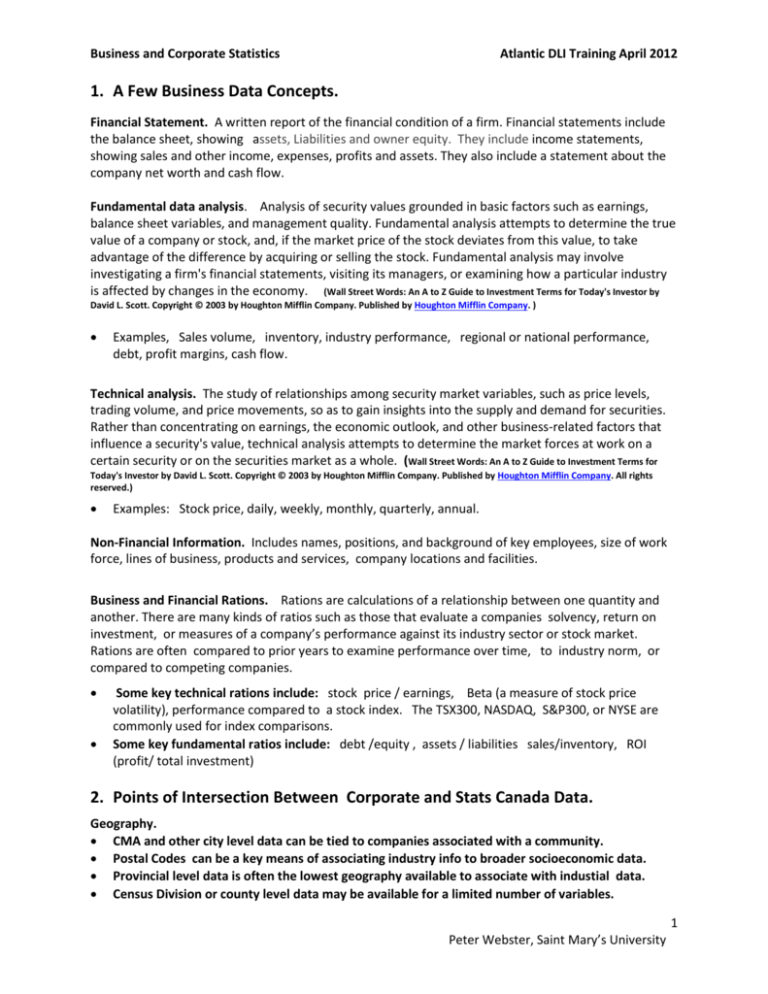
Business and Corporate Statistics
Atlantic DLI Training April 2012
1. A Few Business Data Concepts.
Financial Statement. A written report of the financial condition of a firm. Financial statements include
the balance sheet, showing assets, Liabilities and owner equity. They include income statements,
showing sales and other income, expenses, profits and assets. They also include a statement about the
company net worth and cash flow.
Fundamental data analysis. Analysis of security values grounded in basic factors such as earnings,
balance sheet variables, and management quality. Fundamental analysis attempts to determine the true
value of a company or stock, and, if the market price of the stock deviates from this value, to take
advantage of the difference by acquiring or selling the stock. Fundamental analysis may involve
investigating a firm's financial statements, visiting its managers, or examining how a particular industry
is affected by changes in the economy. (Wall Street Words: An A to Z Guide to Investment Terms for Today's Investor by
David L. Scott. Copyright © 2003 by Houghton Mifflin Company. Published by Houghton Mifflin Company. )
Examples, Sales volume, inventory, industry performance, regional or national performance,
debt, profit margins, cash flow.
Technical analysis. The study of relationships among security market variables, such as price levels,
trading volume, and price movements, so as to gain insights into the supply and demand for securities.
Rather than concentrating on earnings, the economic outlook, and other business-related factors that
influence a security's value, technical analysis attempts to determine the market forces at work on a
certain security or on the securities market as a whole. (Wall Street Words: An A to Z Guide to Investment Terms for
Today's Investor by David L. Scott. Copyright © 2003 by Houghton Mifflin Company. Published by Houghton Mifflin Company. All rights
reserved.)
Examples: Stock price, daily, weekly, monthly, quarterly, annual.
Non-Financial Information. Includes names, positions, and background of key employees, size of work
force, lines of business, products and services, company locations and facilities.
Business and Financial Rations. Rations are calculations of a relationship between one quantity and
another. There are many kinds of ratios such as those that evaluate a companies solvency, return on
investment, or measures of a company’s performance against its industry sector or stock market.
Rations are often compared to prior years to examine performance over time, to industry norm, or
compared to competing companies.
Some key technical rations include: stock price / earnings, Beta (a measure of stock price
volatility), performance compared to a stock index. The TSX300, NASDAQ, S&P300, or NYSE are
commonly used for index comparisons.
Some key fundamental ratios include: debt /equity , assets / liabilities sales/inventory, ROI
(profit/ total investment)
2. Points of Intersection Between Corporate and Stats Canada Data.
Geography.
CMA and other city level data can be tied to companies associated with a community.
Postal Codes can be a key means of associating industry info to broader socioeconomic data.
Provincial level data is often the lowest geography available to associate with industial data.
Census Division or county level data may be available for a limited number of variables.
1
Peter Webster, Saint Mary’s University
Business and Corporate Statistics
Atlantic DLI Training April 2012
Industry Sector / Line of Business.
Standard Industrial Codes (SIC) have been used by both business sources and Statistics Canada to
compile industry data.
North American Industry Classification System (NAICS) is another useful means of comparing
commercial business data to Statistics Canada.
CanSim and other sources list industry related data directly by topic. Steel production,
housing starts, or automobile purchases are examples.
Economic Indicators / Leading Indicators.
Individual corporate performance is also often compared to the national economic indicators, such
as GDP, CPP.
Statistics Canada’s Canadian Composite Leading Indicator is comprised of ten components which
lead cyclical activity in the economy and together represent all major categories of Gross Domestic
Product (GDP). It thus reflects the variety of mechanisms that can cause business cycles. Som
indicators are available back to 1952. Leading index will always be more volatile than GDP since the
components are specifically selected as representing very sensitive indicators of total demand and
output.
3. Important Commercial Business Statistics Sources to Know About.
Mergent Online.
A database of corporate information covering over 22,000 US and International public companies. It
offers a suite of information resources that enables in depth business and financial research. Search by
executive's name, auditor, country code, NAICS or SIC industry code, and selected financial
characteristics and ratios. Customized output reports can be created.The following resources are
included:
Corporate history including acquisitions and changes in ownership structure
Lists of subsidiaries, property holdings, and key personnel
Corporate and financial info. on companies, as well as proprietary analyses of stocks and bonds.
Up to 25 years of annual and quarterly financial data, including balance sheets, income statements,
cash flow statements, and financial ratios.
Up to 10 years of scanned, full-image, annual reports, along with full coverage of SEC filings
Extensive current long term debt information.
US and International Earnings Estimates
D&B Private Company Data,
US and international equity pricing, adjusted and unadjusted,
Industry sector reports.
Corporate news reports.
Standard & Poors CompuStat.
The COMPUSTAT Database contains fundamental financial, statistical and market data for publicly
traded corporations from U.S., Canada. Global Vantage is a supplemental data which which provides
access to data on selected international companies worldwide. It provides extensive coverage of
annual and quarterly income statements, balance sheets, statement of cash flows, and supplemental
data items. It provides more than 340 annual and 120 quarterly Income Statement, Balance Sheet, Flow
of Funds, and supplemental data items on more than 10,000 active and 9,400 inactive companies. It is
updated quarterly. Data is from the 1950’s forward. Research Insight is the Windows interface to
access Compustat and Global Vantage from Standard and Poor’s.
2
Peter Webster, Saint Mary’s University
Business and Corporate Statistics
Atlantic DLI Training April 2012
Lexis-Nexis, Canadian Company Profiles file (CANCO)
Wide-ranging Canadian company summary information from sources includes:
CI Technology Database, Harte-Hanks Market Intelligence.
PIERS Trade Intelligence
Report on Business Company Profiles (Globe & Mail)
Financial Post Corporate Surveys-International Company Profiles
American Business Information, InfoGroup
Company Profile Canada, Owen Media Partners
InfoMart (Formerly FPInfomart)
Contains financial and corporate information for approximately 4000 Canadian companies as well as
series of yearly data for each company for more than 240 topics.
Toronto Stock Exchange (TSX). Canadian Financial Markets Research Centre (CFMRC).
Daily and monthly TSX trading data about specific securities, including dividends, stock splits,
recapitalization borrowing, etc., information on daily and monthly index levels; as well as selected other
financial markets information. TSX is available online via U of Toronto CHASS, or annually on DVD disk.
Centre for Research in Securities Pricing (CRSP)
This historical database offers US daily corporate actions, price, volume, return, and shares outstanding
data for securities with primary listings on the NYSE, NASDAQ, Amex, and ARCA exchanges, as well as
corporate and government bonds, mutual fund data. Coverage of the NYSE is daily from 1925. Limited
to U.S. stocks, focus is on historical
Bloomberg Professional and other Services via Bloomberg terminals.
Real time, access to stock, bond and related trading data, balance sheet data news, analytics,
communications, charts, liquidity, functionalities and trading execution services. Over 400,000 U.S. and
international companies are tracked. Focus is on real time decision making, not on historical analysis.
Thomson Datastream.
Data is available for over 45 countries and over 12,000 companies, back as far as 1976. Coverage
includes Asia/Pacific, Australia, Canada, Emerging Markets, Europe, Japan. US Aggregates, Global
Aggregates, Sector and Industry Aggregates are provided, in addition to individual company coverage.
Earnings forecasts of all stocks in an index, country, or industry. Historical data to identify trends and
market changes. Windows client based software for data analysis, forecasting and modeling.
Wharton Research Data Services (WRDS).
Business data research service used for research by over 290 institutions world-wide. WRDS providing
access to financial, economic, and marketing data though a uniform, web-based interface. WRDS
provides access to COMPUSTAT, CRSP, Thomson IBES, NYSE-TAQ, Bureau van Dijk, Global Insight, and
other important business research databases.
4. Publically Available Business Data Sources; some useful URLs.
NAICS. Free NAICS code and SIC code lookup and concordance. http://www.naics.com/info.htm
Statistics Canada NAICS search. http://stds.statcan.gc.ca/naics-scian/2002/ns-rn-eng.asp?go=1
Census Geography from Wikipedia. http://en.wikipedia.org/wiki/Census_geographic_units_of_Canada
3
Peter Webster, Saint Mary’s University
Business and Corporate Statistics
Atlantic DLI Training April 2012
Postal Codes in Canada from Wikipedia. http://en.wikipedia.org/wiki/Postal_codes_in_Canada
SEDAR. Canadian required public financial reporting site. www.sedar.com
EDGAR. US SIC required public filings. http://www.sec.gov/edgar.shtml
Manta (free business lookup) http://www.manta.com/world/North+America/Canada/Nova+Scotia/
Statistics Canada Economic Indicators. http://www.statcan.gc.ca/tables-tableaux/sumsom/l01/ind01/l3_3764_1880-eng.htm?hili_indi02
5. Community Economic Statistics, a few examples from the region.
Fredericton Statistics (including major employer)
http://www.teamfredericton.com/en/communityprofile/Statistics.asp
Halifax Statistics (including major employers)
http://www.greaterhalifax.com/en/home/economicdata/business/majoremployers.aspx
Moncton major employers. http://www.greatermoncton.org/en/home/
Invest_in_Greater_Moncton/whygreatermoncton/majorpublicandprivatesectoremployers.aspx
Pictou County (NS) major employers. http://pictourda.ca/major-employers/
4
Peter Webster, Saint Mary’s University



